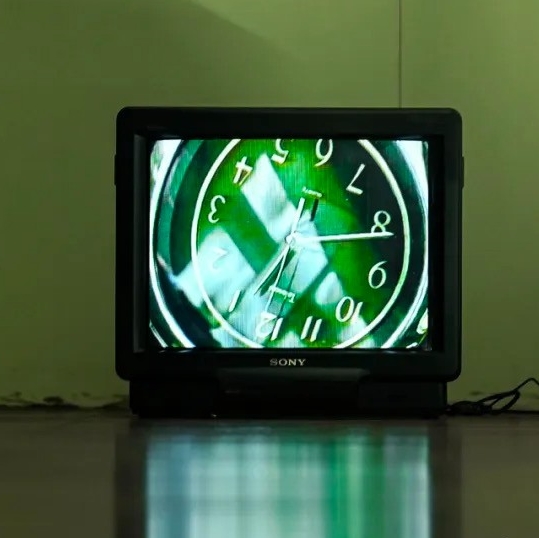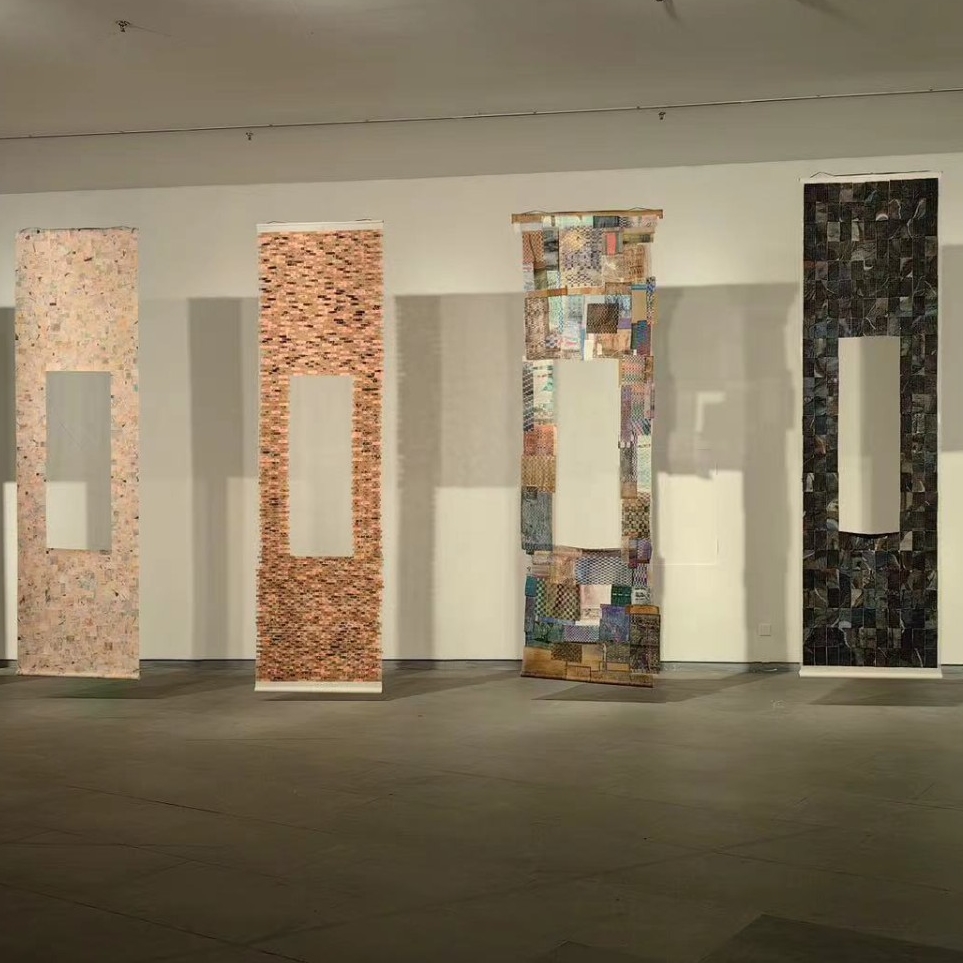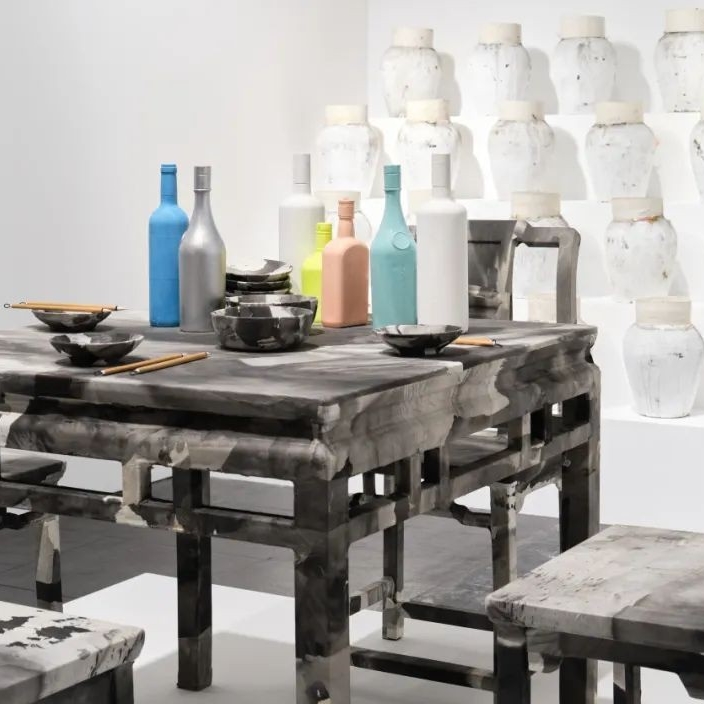Today, when gender equality has become a social consensus, we are often confronted with a contradictory opinion when discussing women’s issues: feminism denotes just a “practice” or “movement” which is aimed at improving the unequal social status of women. It is specific and temporary. Therefore, when its specific social goals are completed, women’s issues will no longer be significant, and feminism will also withdraw from the stage in history. If judged from this standard, then Zhang Yanzi is not a “feminist artist.” But Her 24 Solar Terms is indeed a work about “her,” which also allows Zhang to participate in the heated discussion of women’s topics in the art world in her own unique way. Her creation is different from the common identity politics discourse as she reflects on our time and life from a more embodied female perspective.
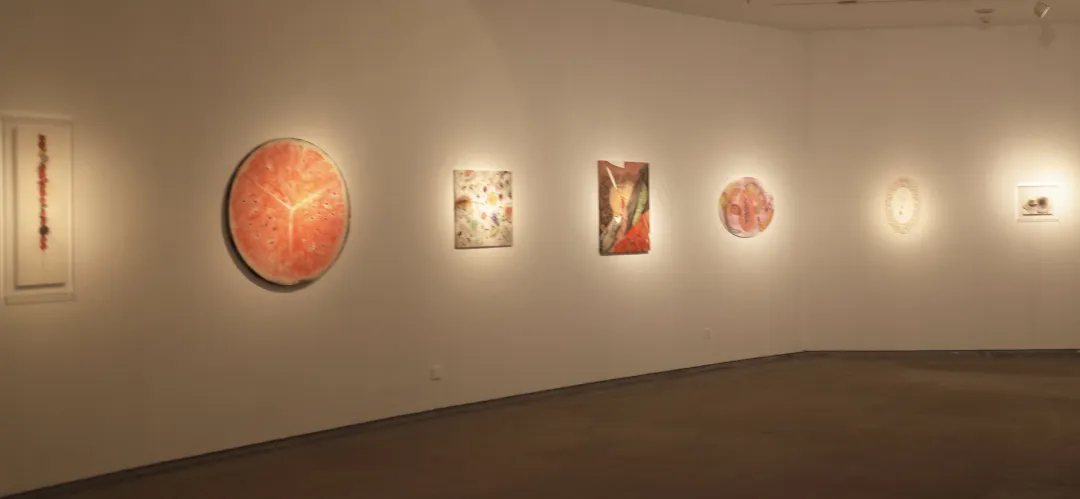
Exhibition View of “Her 24 Solar Terms”
Her 24 Solar Terms originates from the artist’s feelings when she saw strawberries and mulberries on the shelves at the vegetable market. She linked fruits and vegetables with the female body, and formed a microscopic life picture spanning nearly a hundred years with each solar term representing four years of life. For viewers who are familiar with the history of feminist art, her works such as “Spring Equinox” and “Beginning of Autumn” are easily reminiscent of the easel paintings by Georgia O’Keeffe and Judy Chicago with female sexual organ characteristics, which further lead us to the contradictions in feminist art history: O’Keeffe was one of the first group of artists who refused the identity of being a “feminist artist,” while Chicago is a representative of feminist artists who got themselves introduced in textbooks. The representation of the female body was a key issue in Western contemporary art in the late 20th century. The debate on “essentialism” and “constructivism” has appeared in American feminist discussions since the 1980s and has maintained its influence in today’s identity politics battlefield. This association of images in art history reminds us that we cannot simply assume the universality of a feminist political ideal—although this universality is important, it does not mean that all of women agree to it. Here, Zhang Yanzi provides us with a perspective of the other within women: if we do not rely on the existing feminist discourse, can we still think seriously about women? The path that Zhang Yanzi has chosen is body. Undoubtedly, body is at the core of this series of works, it does not appear as a theoretical concept, but as a living material reality; it does not work as a tool for power and ideological analysis, but as a medium of energy and emotion.In this sense, if we do not pay attention to the special significance of the differences in the female body in this series, but try to summarize it with some broad terms in the name of universality—such as turning to a general “body beyond gender”—we will not be able to perceive the potential contained therein.
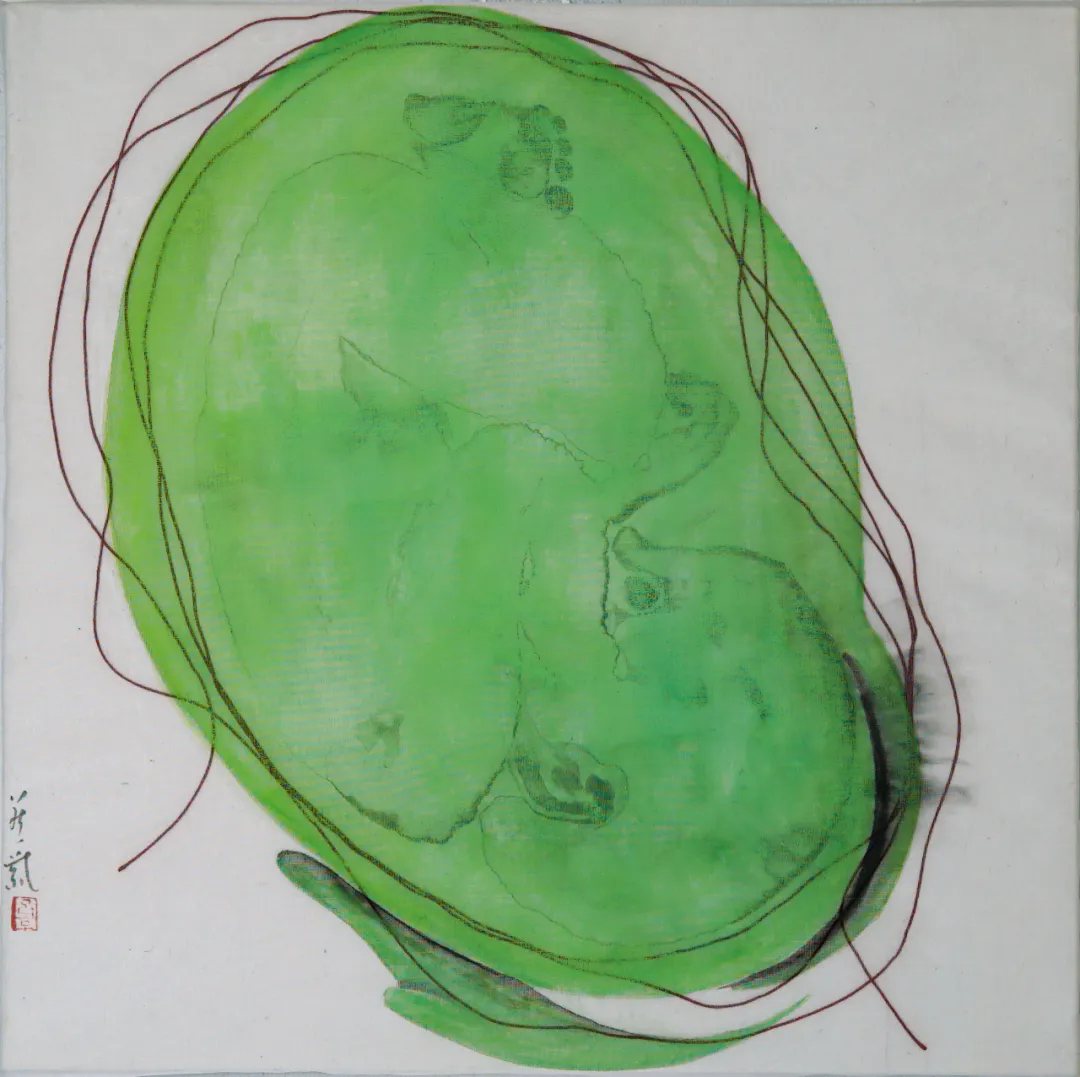
"Start of Spring", 30x30cm, Mixed media, 2022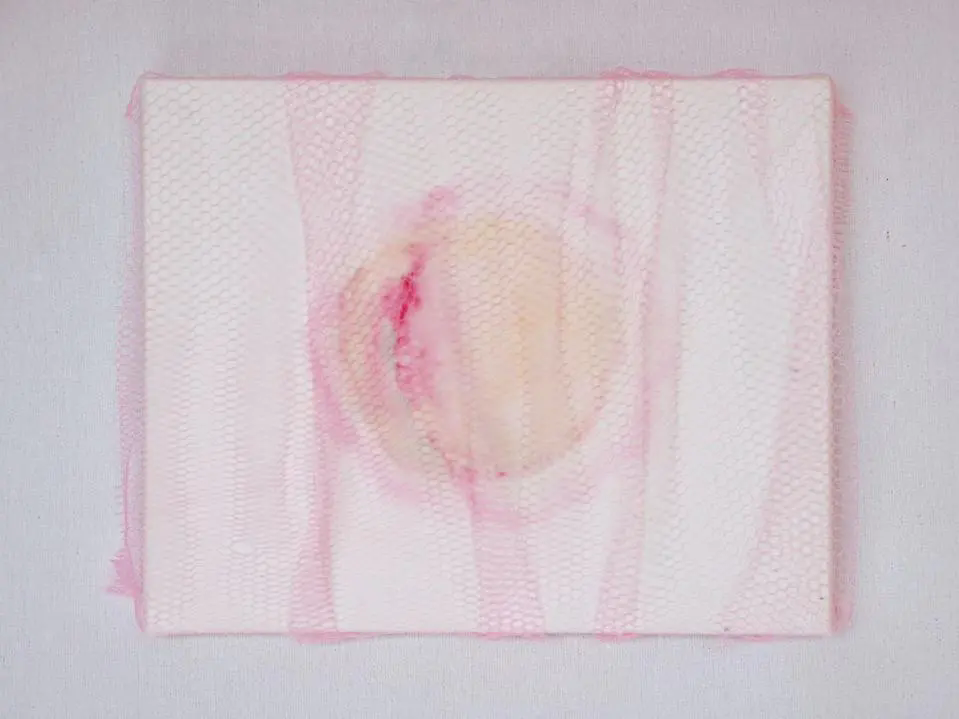
 “Beginning of Autumn”, 60x80cm, Mixed media, 2022
“Beginning of Autumn”, 60x80cm, Mixed media, 2022
As early as the end of the last century, ecofeminists had already noticed that women are to patriarchy just as nature is to capitalism. In their respective situations, they are subjected to systematic violence. On the one hand, women are naturalized and excluded from the initiative and positivity of social, political and cultural life (this exclusion is achieved by describing bearing children and raising children as women’s “destiny”). Under such a historical debt, even with the help of feminist liberation narratives, the synaesthesia established between a woman and natural objects at a certain moment in her daily life is difficult to comprehensively be expressed. On the other hand, the binary relationship established between men/women and culture/nature has marked the subject of modernity with violence. In this relationship, one party claims the subordinate status of the passive party by occupying the initiative, and this deep violence constitutes the symbol of modern society and makes it impossible for modern society to get rid of its traces.

“Spring Equinox” (detail), 60x42cm, Mixed media, 2022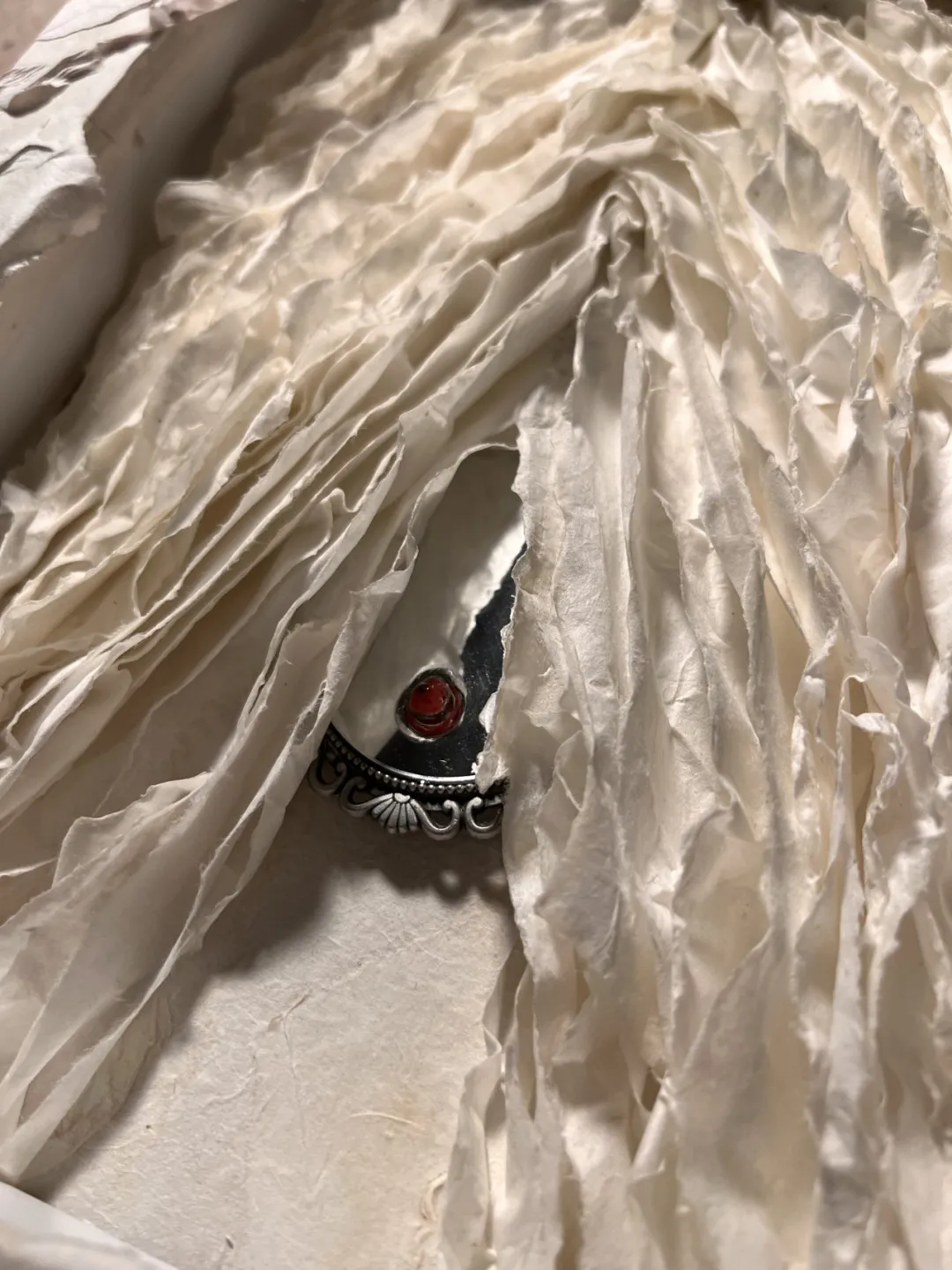 “Grain Rain” (detail), 34x25cm, Mixed media, 2022
“Grain Rain” (detail), 34x25cm, Mixed media, 2022
However, this does not mean that women can only create under this burden of violence. As Marguerite Duras wrote in The North China Lover (1991), “Women would save a lot of time if they could get beyond the idea that they had to correct history.”Her 24 Solar Terms lightly puts aside the politics and history of identity and explores the body and nature from a strictly individual perspective. It is through this strict self-limitation that Zhang Yanzi is able to bypass the essentialist issues that have long plagued feminism and look directly at the long-ignored material issues. The connection between the female body and fruits and vegetables opens up the issue of women and nature at the same time.
By imagining the relationship between the body and fruits and vegetables, Zhang Yanzi reawakens the suppressed potential of women and nature. What is particularly important is that this awakening is not carried out through a more equal planning by a subject identity. In Her 24 Solar Terms, women, fruits and vegetables do not respond to their history of oppression, do not express the similar structures mentioned above, nor do they adopt the usual “vocal” strategy of feminist identity politics (text symbols are compressed to a minimum in the work), but continue to remain silent. In contrast to this silence is the expression of the ever-changing fresh life, which contains unquestionable energy. The germination of a bean in “Beginning of Spring”, the abundance of watermelons in “Summer Solstice”, the smudge of mulberries in “Autumnal Equinox”, the dormancy of Cordyceps sinensis in “Major Cold”... The traditional Chinese concept of “seasons” has become a new path to rethink nature and time: time rushes forward, pushing life to be born, developing, weakening, and dying; nature is not just a medium for cultural creation, and we do not make nature surrender and seize its property, on the contrary, nature breeds culture and is unpredictable, making cultural creativity open to the unknown. Thus, we see a connection between nature and women that transcends essentialism, and the history of the “naturalization” of the female body has been transformed into a valuable resource that transcends the closed modern subject. Zhang Yanzi’s synaesthesia inspired by fruits and vegetables points out the new subjectivity demonstrated by the female body: the temporary, fragile, and aging material life that is devalued under the dualism of body and mind is precisely a place of vitality with abundant potential for creativity.
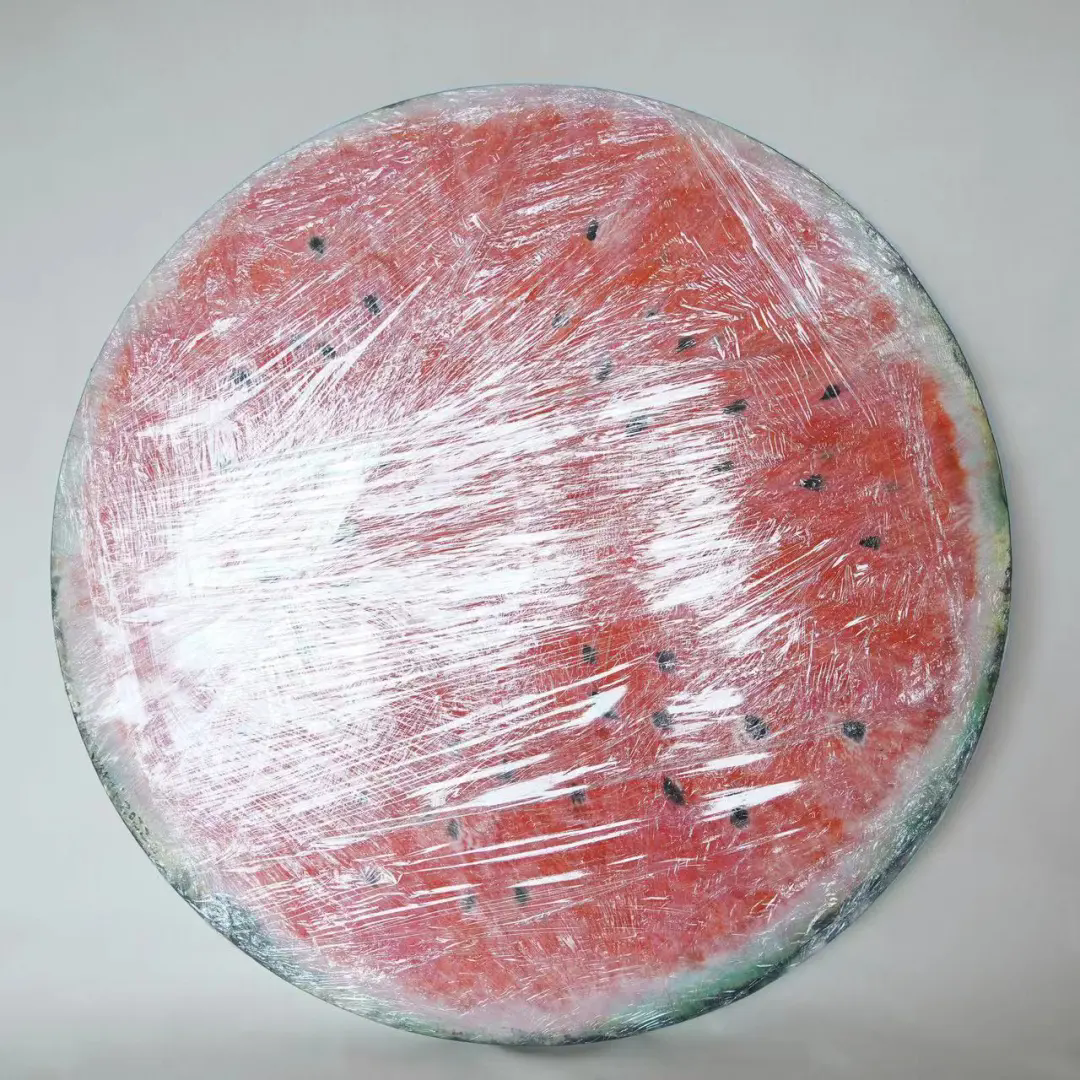
“Summer Solstice” , 98x98cm, Mixed media, 2022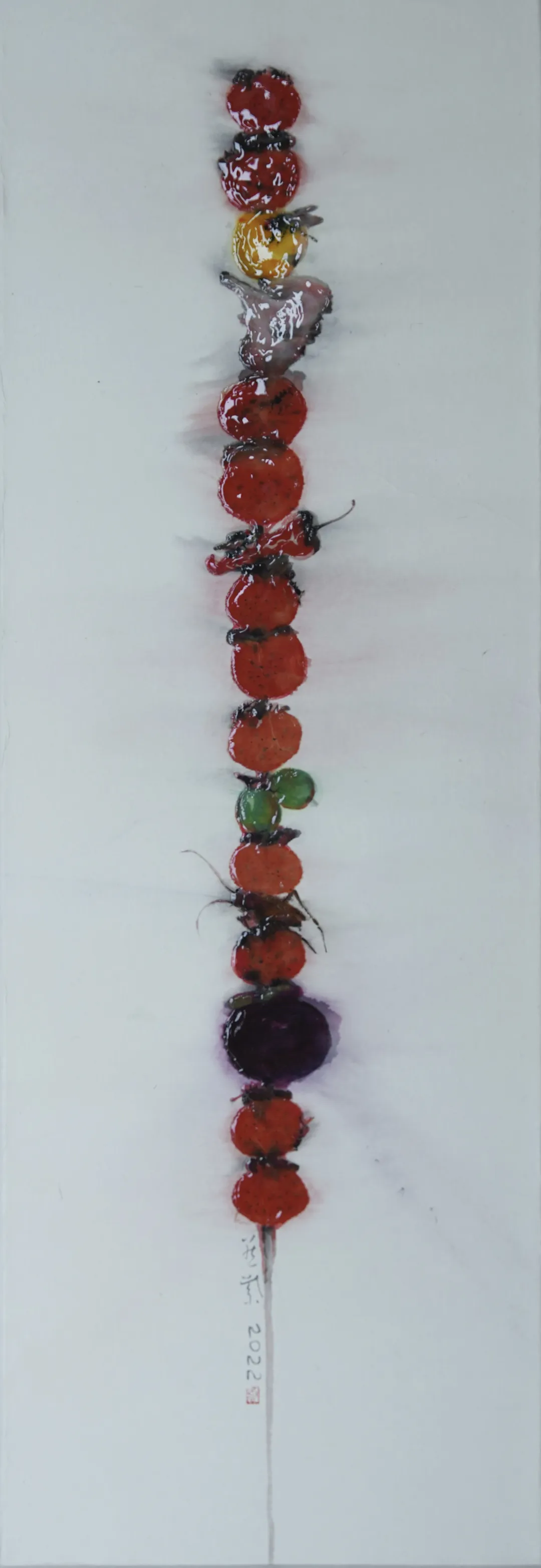 “Grain in Ear” , 84x28cm, Mixed media, 2022
“Grain in Ear” , 84x28cm, Mixed media, 2022
 “Grain in Ear”creative process
“Grain in Ear”creative process
In The Human Condition (1958), Hannah Arendt regards mortality as a condition of public life. It is precisely because life is short that humans desire to leave a lasting mark on the world with the help of the collective and begin to live actively. The ever-flowing nature of temporality pushes the collective to overcome the temporality of the individual and pushes creativity to surge into the future. At the same time, there is a direct conceptual connection between mater and materiality, and modernity suppresses the potential and initiative of both. Therefore, in Her 24 Solar Terms, we see a way to turn from individual time to collective time. By recalling the past and present of herself and her elders and relatives, the artist makes the 24 solar terms in the work an allegory of female time: time is engraved in a woman’s body, and she is repeated in unique experiences such as menstruation, pregnancy, and menopause, and also stimulates new potential in the unique experience of each woman.
This allegory does not envision a certain gender utopia. It comes from the materiality of life and is open to an unknown future. Here, the repetition of women’s bodily experience does not mean being controlled and limited. On the contrary, it allows each individual to stimulate vitality in their specific bodily specificity. Just as men’s bodies have never been pregnant, not all women’s bodies will become pregnant. In the body of every pregnant woman, the mother’s experience may represent surprise, joy, pain, or stability, which means that treasure or burden is unpredictable, but either may become the condition for the new subjectivity of mother and child, just like the evolution of life itself.
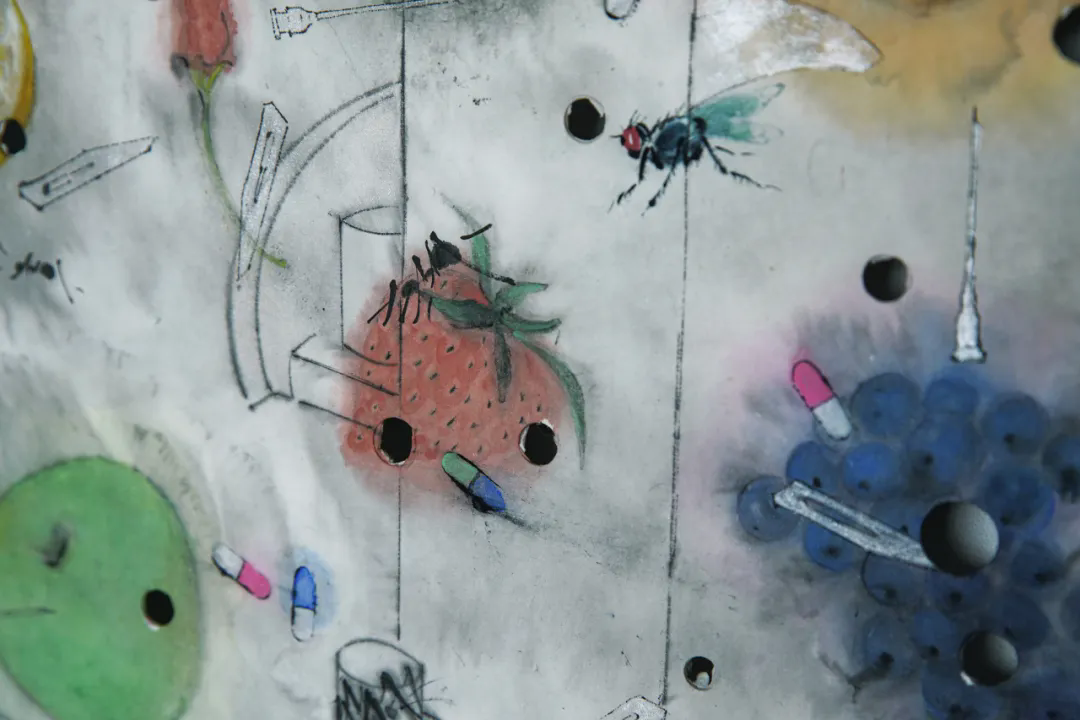
“Minor Heat”(detail), 60x60cm, Mixed media, 2022 “Autumn Equinox” (detail), 60x42cm, Mixed media, 2022
“Autumn Equinox” (detail), 60x42cm, Mixed media, 2022
The image of insects is particularly significant, and they appear many times throughout the series. In the traditional still life painting, insects are often used as a symbol of memento mori, marking the corruption and death of fruits and vegetables, thus emphasizing a material world that should be transcended through art and culture. In Her 24 Solar Terms, insects intervene in the life of the subject as a vibrant other. For fruits and vegetables, insects as the other are both completely different from them and coexist in the same world. This non-human scene implies an ethical space that transcends identity discourse, seeking an understanding of women, nature, and difference itself outside of identity politics. “Minor Heat” is the most vivid presentation of this complex and vibrant world: fruits and vegetables, insects, and medicines are scattered in the picture. Culture and nature are inseparable: the growth of fruits and vegetables is the result of market and agricultural activities; medical symbols are elements that Zhang Yanzi often involves in her works. The human body has been “cyborgized” under the gaze of modern medicine. Medicines do not only cure diseases, but also participate in the transformation of spirit and body; insects have accompanied the human species throughout their time on the earth. This huge and ancient group of others continues to call us, reminding us that as a species on this planet—over a long time, just like individuals, countless species are born and then die—the complex relationship between us and other species requires us to understand ourselves today. A blender blade outlined by lines is located in the center of the picture, and the real holes all over the picture remind us of the cruel side behind the vigorous vitality. In this term representing the age of 44, the artist recalls the chaos and pressure confronted by a middle-age life. When we face the real world full of energy, we should not forget that there is never a lack of conflicts and challenges in the harmonious nature —when fruits and vegetables meet insects and flies, scars are unavoidable. When the vibrant lives of each meet on the stage of the world, we must acknowledge that a kind of cruelty is always present in this theatre, whether the actors are men, women, non-humans, or some newer “post-humans.”
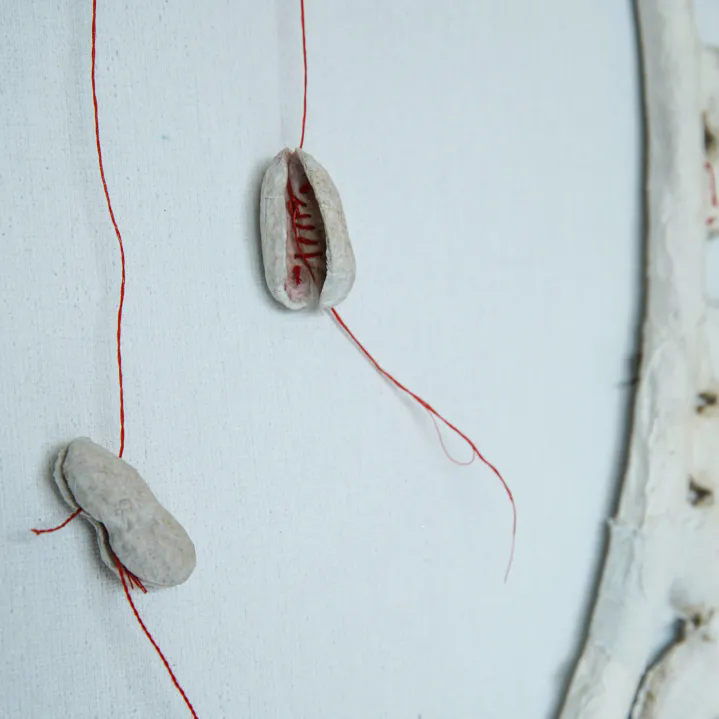
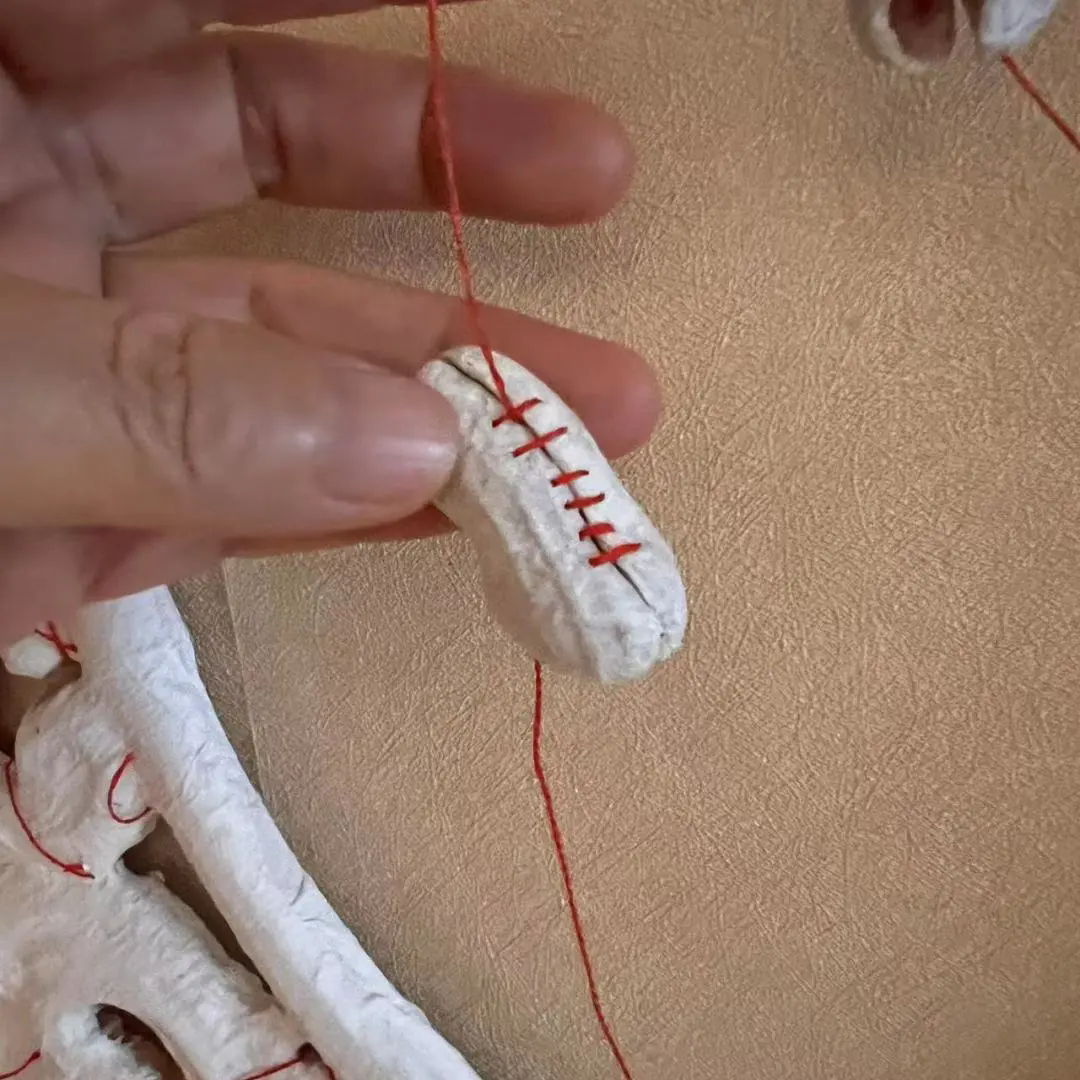
“Limit of Heat” (detail) and creative process
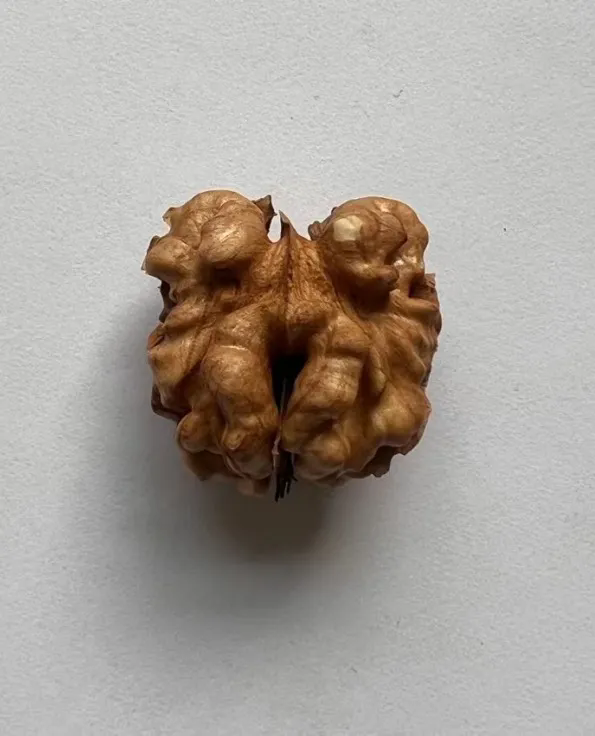 “Minor Cold”creative process
“Minor Cold”creative process
In Éthique de la différence sexuelle (1984), Luce Irigaray claimed that gender differences have never been truly realized, and women have always appeared to lack, be opposite and the opposite of a single human subject. What would a world that truly respects differences look like? Here, feminism intersects with today’s posthuman condition: the problem is not simply to think, judge and create as some other identity (trying to grasp a certain “truth” about women and non-humans is strictly impossible), but how to think, judge and create in a different way, so as to provide space for an unprecedented future. It is in this sense that today’s art world is passionate about talking about objects, emotions and ecology. Through Her 24 Solar Terms, Zhang Yanzi shows a way to create art about women today. She refuses to be confined to the self-repetition of identity and refuses to create as a “woman” symbolized by society—in the drama of desire that symbolizes order, concepts such as “female artist”, “feminism”, “female art”, “feminist art” and so on have troubled us for quite a long time. Based on the concern for real life, Her 24 Solar Terms takes the energy of emotions seriously. It is neither abstract nor detached from concrete objects and history. It reminds us and connects us to the positive ethical relationship with others and the world. In the power relations of global capitalism today, this understanding of the subject of difference helps to deal with the typical schizophrenia symptoms of this era: this symptom means that we must learn to coexist with our contradictory and even incompatible energy and time and space. As shown in “The Major Heat” (which is the most shocking piece for me in the series), the fabrics are entangled, pulled, and full of tension, like a web of life covering this planet. Here, “women” are both witnesses of history and the source of new knowledge, action, and creative power.

“Descent of Frost” ,24x30cm, Mixed media, 2022 “Major Cold”, 57x50cm, Mixed media, 2022
“Major Cold”, 57x50cm, Mixed media, 2022 “Her 24 Solar Terms” series
“Her 24 Solar Terms” series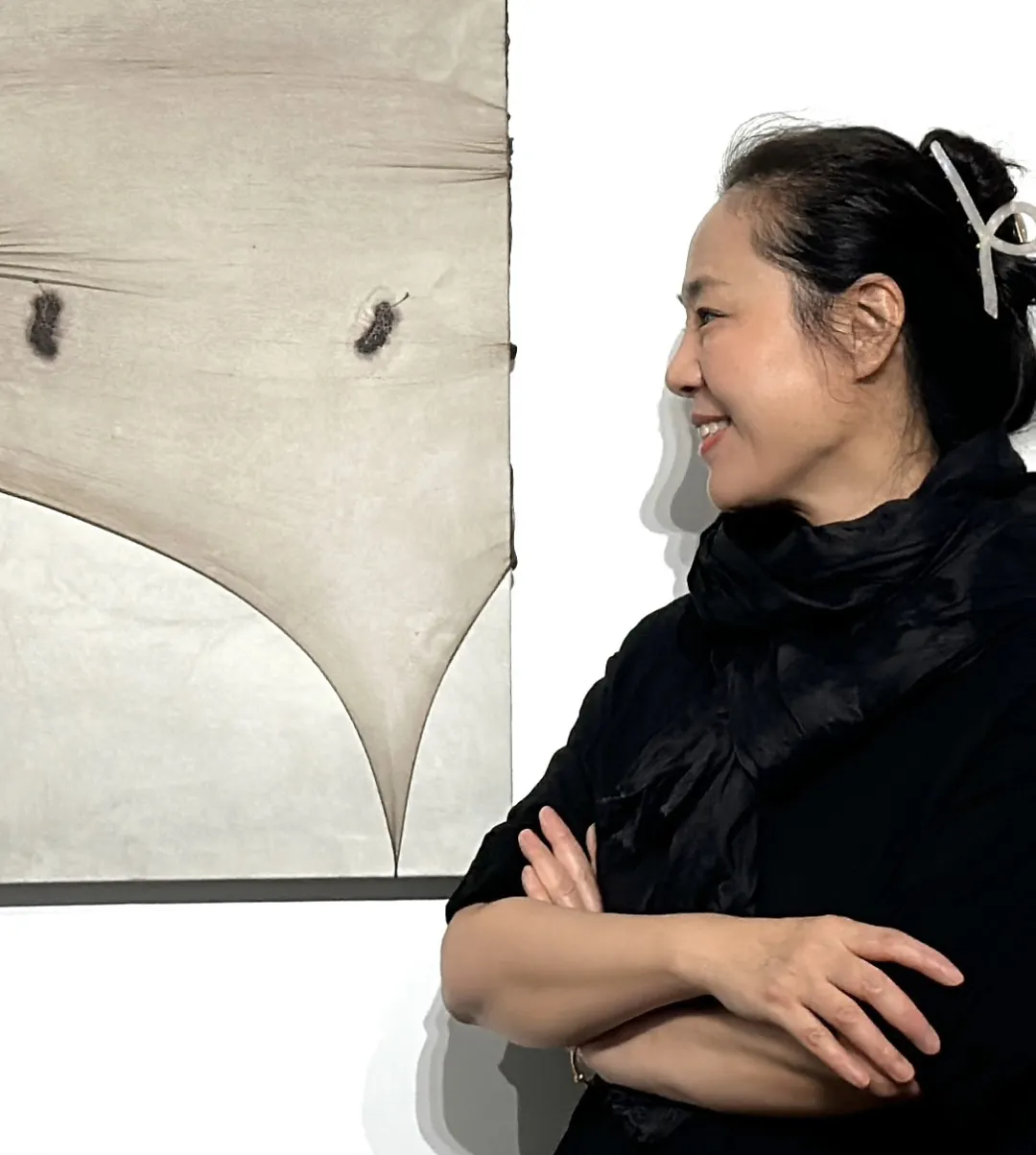 Artist Zhang Yanzi
Artist Zhang Yanzi
About the author
Luo Yifei, PhD candidate of the School of Humanities at the Central Academy of Fine Arts, his research focuses on visual culture studies and he has long been concerned with issues of feminism and art theory.
About the Exhibition
Dates: 30 May- 7 July 2024
Venue: Ora-Ora Tai Kwun
Address: 105-107, Barrack Block, Tai Kwun, Central, Hong Kong



